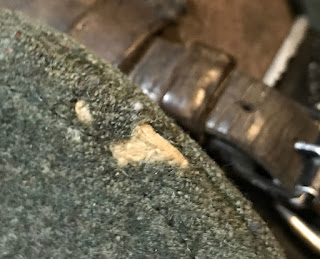This is a wartime German songbook that was distributed as a promotional item by an insurance company in Stuttgart. It's about 50 pages long. The stamp and notation on the title page of this book indicates it was property of a German Army unit during the war.
PDF Download
There are 72 songs in this book. Of interest here is the fact that only the lyrics are included, there is no musical notation. Whoever compiled these songs assumed that soldiers would be familiar with them and know the melodies. Perhaps this may offer some insight into songs that were common and well-known to Wehrmacht soldiers.
There are 72 songs in this book. Of interest here is the fact that only the lyrics are included, there is no musical notation. Whoever compiled these songs assumed that soldiers would be familiar with them and know the melodies. Perhaps this may offer some insight into songs that were common and well-known to Wehrmacht soldiers.
The book includes the lyrics to the following songs:
A list of the 72 songs:
Als wir nach Frankreich zogen
Als wir jüngst in Regensburg waren
Am Brunnen vor dem Tore
An der Nordsee, an der Donau (Jawoll - das stimmt - Jawoll)
Argonnerwald
Auf dem Berg so hoch da droben
Auf der Heide blüht ein kleines Blümelein (Erika)
Auf der Lüneburger Heide
Auf die schwäb'sche Eisenbahne
Auf, hebt unsre Fahnen
Auf Wiederseh'n, mein Schätzelein (Heut' stechen wir ins blaue Meer)
Burschen heraus
Das ist nun einmal so (Wenn ein Soldat ein Mädel liebt)
Das schönste Blümelein, das ich kenn
Der Gott, der Eisen wachsen liess
Des morgens, wenn ich früh erwach'
Die blauen Dragoner
Die Ganze Kompanie (Stolz marschieren wir zu drei'n)
Drei Lilien, drei Lilien
Drunten im Unterland
Ein Heller und ein Batzen
Ein Schifflein sah ich fahren
Ein Tiroler wollte jagen
Engelland (Heute wollen wir ein Liedlein singen)
Es ist so schön, Soldat zu sein (Rosemarie)
Es steh'n drei Birken auf der Heide
Es war ein Edelweiss, ein kleines Edelweiss
Es wollte sich einschleichen
Flieg', deutsche Fahne, flieg'!
Frühmorgens wenn die Hähne kräh'n
Frühmorgens wenn die Sonn aufgeht (Tschingta, tschingta Bummtara!)
Hab mein Wage voll gelade
Heiss ist die Liebe
Heute geht's an Bord
Heute wollen wir's probieren (Westerwald-Lied)
Hoch auf em gelben Wagen
Ich bin ein freier Wildbretschütz
I bin Soldat
Ich sing mir ein Lied
Ich trag in meinem Ranzen...
Jetzt gang I ans Brünnele
In Sanssouci am Muhlenberg (Veronika)
Im Feldquartier auf hartem Stein
Im schönsten Wiesengrunde
Kennt ihr das Land
Liebchen ade! (Annemarie)
Liebling, wenn ich traurig bin
Lippe-Detmold, eine wunderschöne Stadt
Märkische Heide, märkische Sand
Mein Regiment, mein Heimatland
Morgen marschieren wir in Feindesland
Muss i den zum Städtele naus
Nur der Freiheit gehört unser Leben
Schwarzbraun ist die Haselnuss
Soldat sein, heist true sein
Soldaten sind immer Soldaten
Steh' ich in finst'rer Mitternacht
Tirol, du bist mein Heimatland
Und die Morgenfrühr, das ist unsere Zeit
Von den Bergen rauscht ein Wasser
Was glänzt dort vom Walde
Weit last die Fahnen wehen
Wenn alles grunt und blüht
Wenn alle Brünnlein fliessen
Wenn all untreu warden
Wenn die bunten Fahnen wehen
Wenn wir marschieren
Wilde Gesellen, vom Sturmwind durchweht
Wir marschieren alle in gleichem Schritt
Wo e' Klein's Hütt'le steht
Wohlan, die Zeit ist kommen
Wohlauf, Kameraden, aufs Pferd
Als wir nach Frankreich zogen
Als wir jüngst in Regensburg waren
Am Brunnen vor dem Tore
An der Nordsee, an der Donau (Jawoll - das stimmt - Jawoll)
Argonnerwald
Auf dem Berg so hoch da droben
Auf der Heide blüht ein kleines Blümelein (Erika)
Auf der Lüneburger Heide
Auf die schwäb'sche Eisenbahne
Auf, hebt unsre Fahnen
Auf Wiederseh'n, mein Schätzelein (Heut' stechen wir ins blaue Meer)
Burschen heraus
Das ist nun einmal so (Wenn ein Soldat ein Mädel liebt)
Das schönste Blümelein, das ich kenn
Der Gott, der Eisen wachsen liess
Des morgens, wenn ich früh erwach'
Die blauen Dragoner
Die Ganze Kompanie (Stolz marschieren wir zu drei'n)
Drei Lilien, drei Lilien
Drunten im Unterland
Ein Heller und ein Batzen
Ein Schifflein sah ich fahren
Ein Tiroler wollte jagen
Engelland (Heute wollen wir ein Liedlein singen)
Es ist so schön, Soldat zu sein (Rosemarie)
Es steh'n drei Birken auf der Heide
Es war ein Edelweiss, ein kleines Edelweiss
Es wollte sich einschleichen
Flieg', deutsche Fahne, flieg'!
Frühmorgens wenn die Hähne kräh'n
Frühmorgens wenn die Sonn aufgeht (Tschingta, tschingta Bummtara!)
Hab mein Wage voll gelade
Heiss ist die Liebe
Heute geht's an Bord
Heute wollen wir's probieren (Westerwald-Lied)
Hoch auf em gelben Wagen
Ich bin ein freier Wildbretschütz
I bin Soldat
Ich sing mir ein Lied
Ich trag in meinem Ranzen...
Jetzt gang I ans Brünnele
In Sanssouci am Muhlenberg (Veronika)
Im Feldquartier auf hartem Stein
Im schönsten Wiesengrunde
Kennt ihr das Land
Liebchen ade! (Annemarie)
Liebling, wenn ich traurig bin
Lippe-Detmold, eine wunderschöne Stadt
Märkische Heide, märkische Sand
Mein Regiment, mein Heimatland
Morgen marschieren wir in Feindesland
Muss i den zum Städtele naus
Nur der Freiheit gehört unser Leben
Schwarzbraun ist die Haselnuss
Soldat sein, heist true sein
Soldaten sind immer Soldaten
Steh' ich in finst'rer Mitternacht
Tirol, du bist mein Heimatland
Und die Morgenfrühr, das ist unsere Zeit
Von den Bergen rauscht ein Wasser
Was glänzt dort vom Walde
Weit last die Fahnen wehen
Wenn alles grunt und blüht
Wenn alle Brünnlein fliessen
Wenn all untreu warden
Wenn die bunten Fahnen wehen
Wenn wir marschieren
Wilde Gesellen, vom Sturmwind durchweht
Wir marschieren alle in gleichem Schritt
Wo e' Klein's Hütt'le steht
Wohlan, die Zeit ist kommen
Wohlauf, Kameraden, aufs Pferd
































